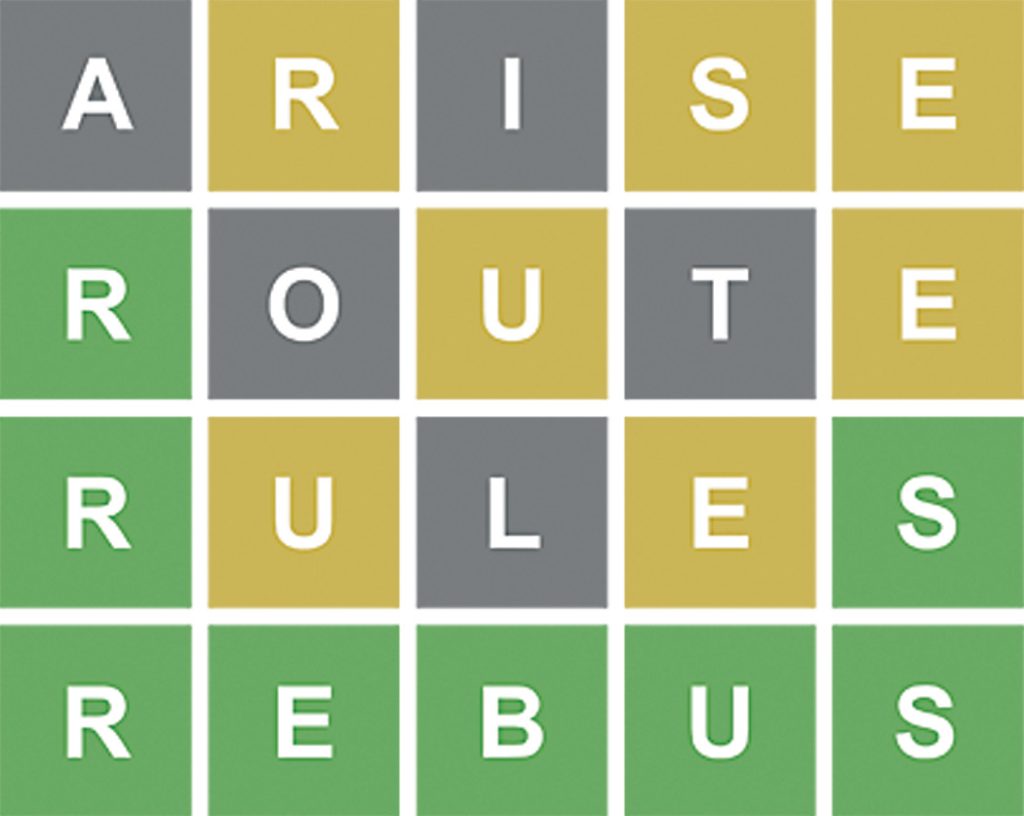
I’ve decided to give you a break. I’d been planning to write about the Ethereum blockchain this month, but that would have been my third crypto-related column this year. So let’s put that abstruse topic on hold and talk about—games!
I’m not a gamer. But there are two word games I now play every day. I never imagined this would happen to me, but these are fun.
First thing every morning I play Wordle (nytimes.com/games/wordle). It was created last year by a computer programmer for his girlfriend. She loved it. He put it online and they shared it with some friends. By November 1, there were 90 people playing regularly. By the beginning of January, that number was over 300,000.
Now there are millions of daily users, and it became so popular that early this year the New York Times bought it for millions of dollars.
Despite it being so popular and fun, you don’t need to worry about addiction, because you’re limited to playing it once a day. I usually solve the puzzle in less than five minutes.
The game simply involves having six chances to guess a five-letter word. You’re presented with a blank grid, five squares wide, and six lines deep. You start by typing a word into the grid, and it shows you if the word you guessed contains any of the letters in the secret word.
If a letter is not only contained in the secret word but is also in the correct spot, it appears green. If it’s contained in the secret word but not in the correct spot, it shows as yellow. Letters not in the secret word appear gray. You then move to the next line and make another guess.
So maybe your first guess contains two correct letters, and your second guess a couple more. You now try to figure out what words contain those letters. You move to the next line and type in another guess.
If you get it right within six tries, you win. Wordle keeps a record of your winning percentage, how many times you’ve won in a row, and the number of times you’ve gotten the correct word on one try, two tries, three tries, etc.
Early on, I failed twice to get the secret word. But I quickly figured out a strategy, and have now won 34 times in a row as I write this in late March. On one occasion I got the correct word on the second guess, and six times on the third.
If you want more of a challenge, there’s an option to turn on Hard Mode.
The other game I play is, naturally, another word game. Words With Friends is a Scrabble knockoff that’s played on smartphones and tablets or in a web browser. A friend got me into it two years ago, and we’ve played nearly every day since then. Like Wordle, it’s free.
A nice feature is that it’s asynchronous, meaning that you don’t need to be online at the same time as the other player. When my friend makes a play, I receive an alert and can then make a play whenever it’s convenient.
As with Scrabble, you each get letters and earn points by making words from those letters, artfully using the locations on the board that double or triple the number of points you earn from a letter or a whole word.
It’s fun, but there’s one major difference between Scrabble and Words With Friends. The latter has a sort of built-in cheat mode. Each day you earn coins through various means, and then use those coins to buy specific aids to play.
For example, the Word Radar feature, which costs 15 coins, highlights in green all the locations on the board where you can play a word. The Swap feature, which costs 20 coins, lets you exchange some or all of your letters before making a play. The game even lets you purchase additional coins, with 220 coins costing $4.99.
My friend and I started out taking advantage of these cheat-like features, and also of anagram websites that let you type in the letters you have and then tell you all the words that can be formed from them. But after a few months we both stopped using any aids. It makes the game simpler and more fun.
While we do play nearly every day, it doesn’t use up much time, typically taking us several days to complete a game, with both of us making plays on our mobile devices as time allows.
Thankfully, I’m not a gamer. Surveys have found that teen boys play an average of three hours per day. Yikes. Some even suffer serious addictions.
We’ll talk about Ethereum in the future. For now, have some fun!
Find column archives at JimKarpen.com.
